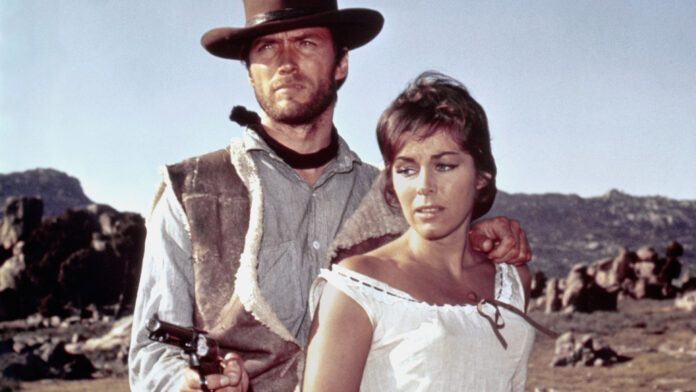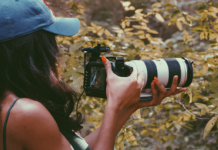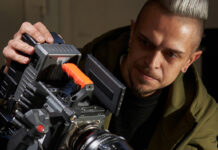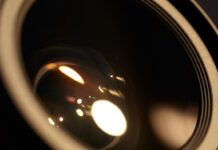In a nutshell
- The American shot is a cross between a medium shot and a wide shot
- It’s often used to communicate confidence and/or heroism
- The American shot is often most widely used in Westerns, but it has its place in other genres
How do changes in camera shots and field of view produce unique, dynamic looks for the screen? Seasoned filmmakers know the right shot for the right mood is essential to the success of a visual story. Enter the famous ‘American shot.’ If you’re looking to convey an intense, heroic or dramatic feel with your shot, the American shot is the crème de la crème of cinematic camera angles. Here’s why.
What is the American shot?
The American shot — AKA the “cowboy” shot — is an altered cross of a medium shot and a wide shot. It’s framed slightly bigger than a medium shot but is smaller scale than a full or wide shot.
In the anatomy of sizes used in shots, a full shot is a complete head-to-toe framing of the subject. A medium shot frames the subject more closely and with more detail. Finally, the close-up shot fills the frame with the subject’s face, keeping the viewer’s attention on the emotion of the character.
The cowboy shot frames a subject from mid-waist to right above the head, with the camera placed at hip level. The term itself is actually a translation of a phrase from French film criticism: “plan américain.” It also got its name from ample use in American Westerns — think John Wayne, Roy Rodgers and the Lone Ranger.
What these cowboys represented in cinema were might, strength, machismo and just being all-around imposing figures. And that’s exactly what the American shot looks to convey onscreen.
What does the American shot accomplish?
Since its conception, filmmakers have used the American shot to convey heroism and confidence from onscreen good guys. And, in some cases — even bad guys.
As a rule, the dramatic shot shows the most exposed parts of the character’s body in the frame. Not out of vulnerability but out of intimidation. Since the American shot falls between the medium and full shot, it balances the framed subject and the background. The filmmaker can express emotion through an actor’s bearing, attitude, posture and expression without having to rely on dramatic close-ups.
In classic westerns, directors used the American shot to draw attention to the actor in an imposing stance. Usually, the actor is ready for action — unholstering a pistol or dramatically spinning a rifle before reloading, the way actor Chuck Connors did in the television western series “The Rifleman” (1958 – 1963).
The American shot is not necessarily a straightforward one. However, it lets filmmakers give audiences the visual effect of looking up at the principal subject. Meanwhile, the camera placement uses perspective to bolster the heroism or intimidating power of the character.
Examples of the American shot in film
The American shot is popular for filming characters as poised and heroic while angling vital actions — such as drawing a weapon — into the shot. The shot ends up revealing the actor’s emotions and mannerisms of toughness, anger, vulnerability or dread. Some examples include classic John Wayne and Clint Eastwood westerns.
The classic 1966 Spaghetti Western, “The Good, the Bad and the Ugly” (1966), frames Eastwood from his gun holster to the top of his head. It’s a stand-off, preparing the viewer for the culminating moment when Eastwood draws his gun from the hip. The opening close-up of Eastwood’s hand hanging over the gun holster immediately establishes a sense of unease in the scene. The tension builds until the moment Eastwood and the other characters draw. Then we see the American shot of our hero, Clint Eastwood, firing the first shot.
Here’s an example of that scene in motion. Eastwood, framed in the American shot, fires his gun first at the end of the clip:
You see this cowboy shot technique in another classic western film. John Wayne’s “The Shootist” (1976). The shot frames our hero with a focus on drawing his weapon while on horseback. Here is that classic scene in action:
In John Wayne’s film “Stagecoach” (1939), the American shot is used to frame Wayne as he spins his rifle. You can see that shot in the opening of the following video. It includes perfect examples of both John Wayne and “The Rifleman” actor Chuck Connors firing their weapons in classic cowboy shots:
The American shot delivers an immediate sense of drama, intensity and doggedness from the protagonist. These are images and emotions not easily evoked by just an extreme close-up or full shot. A close-up shows facial expressions but not body language. Meanwhile, the full shot puts the actor at a distance to capture a sense of strength and heroism.
Examples of the American shot in modern film
In modern cinema, filmmakers have begun to re-associate with classic action and aggression in style and technique by embracing the American shot.
Let’s take a look at the 2011 film “Cowboys & Aliens” (2011) starring Daniel Craig, who plays Jake Lonergan. In this scene, the aliens first attack the old western town. Jake breaks free of his restraints and stands poised and heroic as the alien ships come straight toward him.
Jake is framed from the hip up, with his alien bracelet armed and ready to fire. (See the classic American shot at frames 3:35 and 3:46.)
Another good example of the American shot in modern cinema is from the 2018 18th-century period film, “The Favourite” (2018). The scene shows Lady Sarah firing her pistol at her new servant Abigail (frame 0:28). The American shot portrays Lady Sarah as confident and powerful as she takes aim and fires the weapon.
Another modern example of the American shot happens in the HBO hit series, “Game of Thrones” (2011 – 2019). Here Jon Snow is framed from the knee-up as he draws his sword, Ramsay Bolton’s cavalry advancing toward him. You get a sense of the character’s heroism that can’t be accomplished by a long, wide or close shot.
Conclusion
Now that you know more about the American shot, create your own shot list. Think of how you would use the shot in your own projects. Even if you’re still unsure, test the waters with a project you have in mind or one you’re doing just for fun. It’s not just a technique for cowboy movies. Comic book movies have adapted the technique into their films, as well. Even online influencers have used the shot in their video content.
The American shot can be extremely effective for any film or video project looking to capture emotion, heroism and superiority in any genre you can imagine. So if you are itching to try it out yourself, go for it. The only way you will learn is by doing. To recap, the American shot is an altered cross of a medium shot and a wide shot and has deep roots in the Western genre. It can be great for making scenes more dramatic; however, be careful if you use it. It’s a very stylistic shot and will stand out if it doesn’t fit with the flow of your film. Practice, and you will get an idea of when and if you should use the shot.








